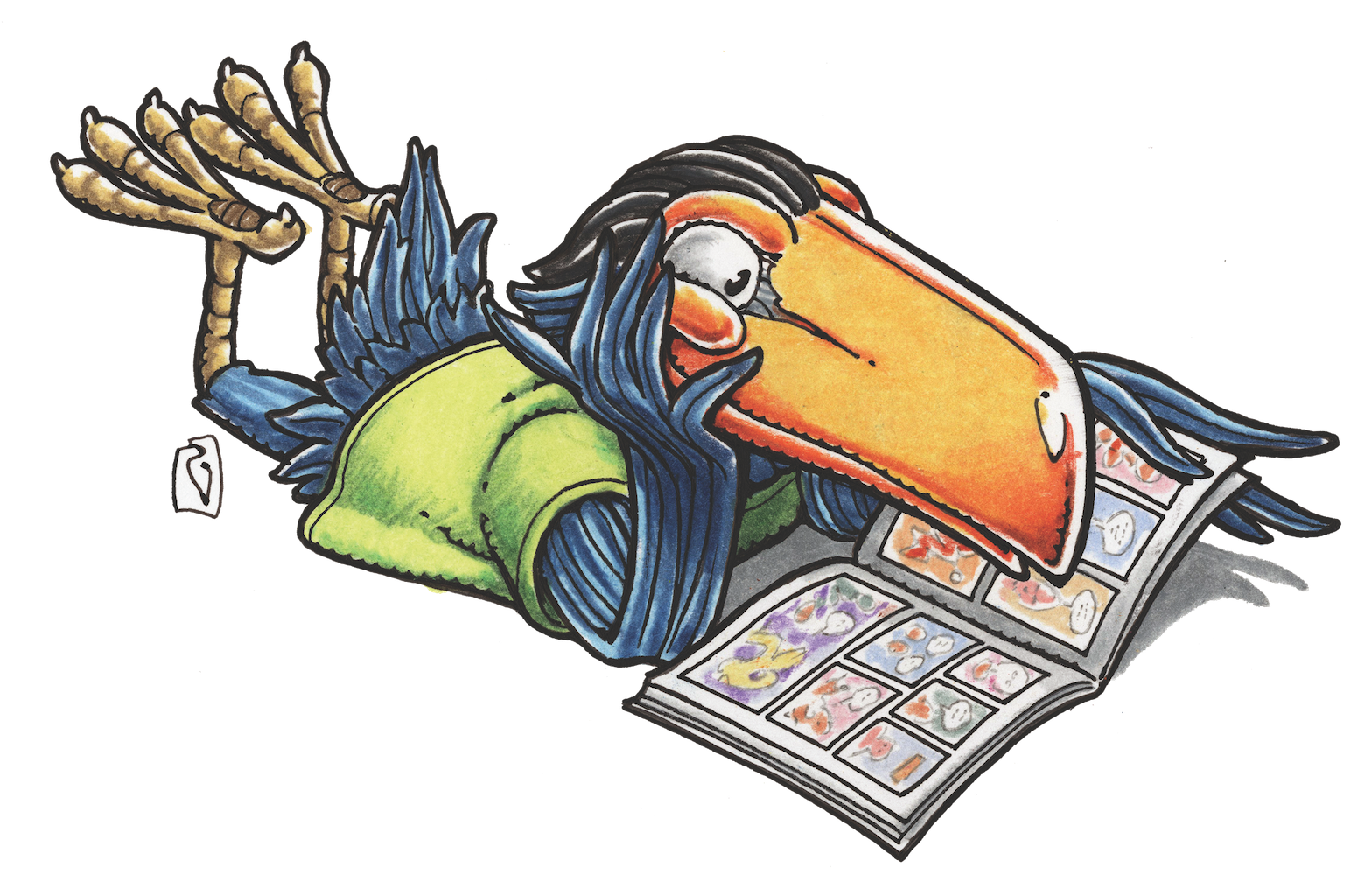JESSE HAMM’S CAROUSEL
Carousel 008: Common Mistakes

Over the years, I’ve given my share of portfolio reviews, and there are certain mistakes and problems that I see again and again. Not every mistake is common—some pioneering souls manage to stumble into problems that are unique to their personal corner of the artistic universe—but there are several classic doozies that I see often enough to merit mention. Banish these from your samples, and you’ll be that much closer to impressing a client and landing a job.
1. Crossing The Line Of Action
The “line of action” is an imaginary line that exists between the main characters in a scene. For clarity’s sake, a good visual storyteller will avoid suddenly moving the reader to the far side of this line. The aim is to be consistent about where readers imagine themselves in the scene, so they can better understand the action.
So, for instance: Imagine a panel in which Character A is chasing Character B from left to right. If, in the next panel, we readers have crossed to the far side of this chase, the characters will suddenly appear to us to be running in the opposite direction: from right to left. Shifts like this can be confusing. Keeping the reader on the same side of the line of action will avoid this confusion. (This principle is also known as “The 180 Degree Rule.”)
2. Inconsistent Vanishing Points
Often, the inexperienced artist will aim most of their perspective lines at a certain vanishing point, but then get lazy and guess about some of the other lines, leading to inconsistencies. So, the bricks and windows of a building will aim at one vanishing point, but then the edges of, say, the door will aim elsewhere. The result looks wonky. To avoid this effect, take special care to ensure that all of the lines in a drawing that are parallel to each other aim at the same vanishing point.
Also, when using “two-point” perspective, be sure that both points are on the same horizon line. Otherwise, the shapes in your environment will appear to tilt.
3. Unreferenced Objects
Too often in amateurs’ samples I see objects, outfits, or animals that were obviously made up, or drawn from a hazy memory. It shows! Until you have drawn an object several times from observation, don’t attempt to draw it without reference. Take a minute to look up a photo of that object to draw from. Your work will look much sharper for it.
4. Flush Surfaces
Inexperienced artists often rely on mere lines to imply depth, rather than drawing the way the shapes recede or extrude. For instance, instead of drawing a shirt-collar or rolled sleeve, which clearly rest on top of the body, they’ll just indicate the shirt by drawing a line around the neck or wrist. Or, instead of a window like the one on the left, below, that stair-steps its way back into the building, they’ll draw a window like the one on the right, that’s flush with the wall.

5. Flat Staging
This relates to the tip above. Inexperienced artists often stage their scenes flatly: positioning the sides of buildings or vehicles perpendicular to the viewer, instead of at an angle. When drawing characters conversing, they’ll often show them directly from the side, in profile, instead of from an angled vantage point (nearer one conversant or the other). This gives the scene a flatness that can look like a bad stage play.
Flat staging can work when done intentionally, to create a humorous sense of detachment (see Wes Anderson’s films, for example), but it’s usually done from ignorance, resulting in scenes that lack depth, dynamism, and a sense of reality. Try instead to portray objects and interactions from diagonal angles.
6. Split Focus
A common mistake among inexperienced cartoonists is trying to cram too many story points into a single panel. Generally, the appropriate number of story points to include in a single panel is: 1 (ONE). Creating multiple areas of focus in a single panel threatens to confuse readers, and causes each focal point to compete with the others, lessening their impact.
When thumbnailing your page, try describing each panel out loud. If you find yourself saying, “The cows escape through the gate in a stampede, and also we notice Black Bart slipping poison into the Sheriff’s chili…,” then you probably need to divide that panel into two panels, or save one of those story points for a later page.
7. Fussy Textures
It’s tempting, when drawing on a full-sized art board, to zero-in on some small portion of the page and add tiny details, hatching, or feathering. (This temptation is even stronger when you’re working digitally and can zoom in at will.) Unfortunately, details that look fine close-up can melt into a confusing blur when the art is reduced for publication. Editors reviewing your work will notice such trouble right away.
To ensure your art will read properly when shrunk, hold up a typical comic book, and lean back from your desk until the art on your page (or monitor) matches the comic’s size. Then peruse your art, searching for places where the lines become indecipherable smears. If you find any such areas, erase and simplify them.
8. Poor Black-Spotting
Too many black shapes scattered around a drawing can have a camouflage effect, confusing the eye. It’s better to combine a drawing’s shadow areas into a few major shapes (or groupings of shapes). Generally, the fewer and simpler the dark shapes (or groupings), the stronger the drawing.
Also, inexperienced artists tend to locate most of their dark areas in one part of the panel, rather than balancing them throughout the panel. While keeping it simple, look for opportunities to balance out a dark area in one part of your panel by adding one or two other dark areas elsewhere in the panel. Artists like Alex Toth, Hugo Pratt, and Mike Mignola are masters at this, and worth studying.
9. Repetitive Textures
Often, a young artist will master a particular texture and then use that texture on every object on the page, creating a weird sameness. We may admire the fiberglass sheen on the car in one panel…but then we notice the same sheen on the character’s leotard, and on her hair and skin, and on the tree trunk, and the wall of the building—everything looks covered in fiberglass! Instead, for verisimilitude, challenge yourself to render a variety of textures: wood, fur, cloth, metal, glass, etc.
10. Thoughtless Cropping
Beginning cartoonists often include too much “air” around the action, showing us distracting parts of the environment that are irrelevant to the panel’s point. Or, they’ll zoom in too close, not showing us enough of the surrounding context to understand what is happening, or where.
To avoid this, make a preliminary thumbnail sketch of each panel, leaving off its borders. Cover its top, bottom and sides with your hands, asking yourself how much you can cover without confusing the reader. Once you’ve found a cropping scheme that works for that panel, draw its borders accordingly, then follow that plan when you sketch the panel on the actual page.
11. Unclear Facial Expressions
I can’t tell you how often I see characters locked in mortal battle, or mourning a loved one, or cracking a joke, with blank looks on their faces. It’s as though the artist learned how to draw a face a certain way and is desperate not to change the expression for fear of screwing it up. Practice drawing different expressions! A character’s face is among the strongest indicators of how the reader should feel about your scene. It’s like a rudder of emotion; use it! Show those feelings!
12. Leftward Action
Readers here in the West read comics from left to right, so it feels “correct” when characters face right and move toward the right. Rightward movement suggests they are moving toward the future, toward the next part of their story.
It can occasionally make sense for characters to move toward the left (such as if they entered a room from the left and are now turning to leave), but this is counterintuitive. When characters move toward the left, it feels like they are swimming against the current, attempting to move backward in time, and heading toward a collision with the previous panel. Whenever possible, it’s best to aim the action toward the right, in the direction the reader is reading.
To be sure, there are other ways (countless ways!) a page can go wrong, but avoiding the problems listed above will improve your work considerably, and give you a good jump on your competition.
Good luck, and see you here next month!
Jesse Hamm’s Carousel appears the second Tuesday of every month here on Toucan!